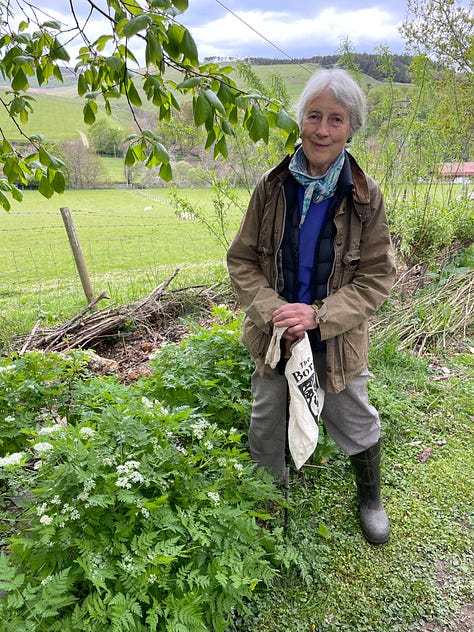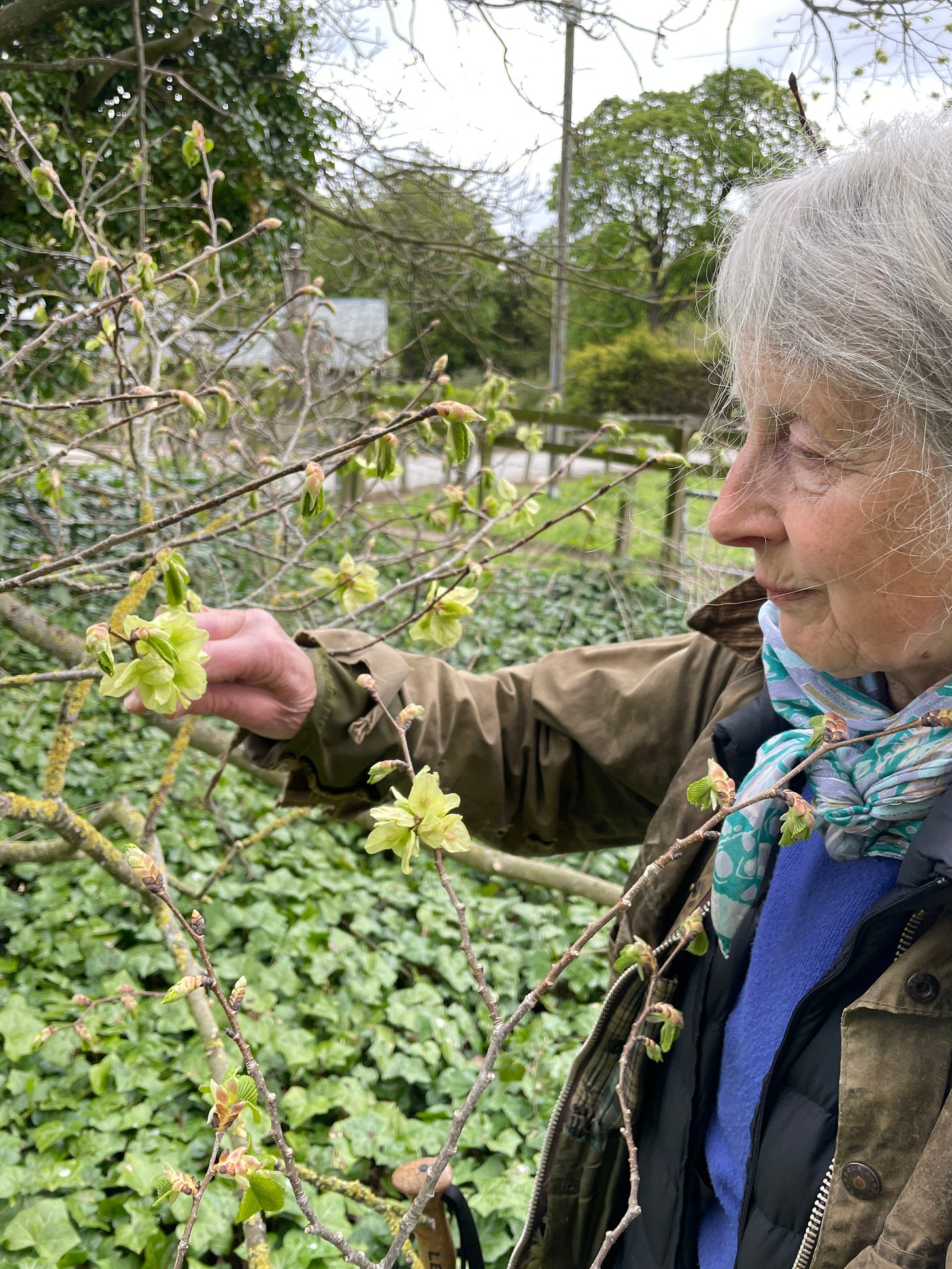It’s been a long time since anyone in the Scottish Borders was forced to gather food from the wild in order to survive. But several hundred years ago, this time of year would have seen many people here and across the UK, turning to nature for their sustenance. May and June were treacherous months for those living off the land. The home larder was depleted after the winter and the garden wasn’t yet producing, giving this season the name of ‘hungry gap’.

At this point, the emerging wild greens, shoots and leaves would have quite literally been lifesavers. These are the plants that today we refer to dismissively as ‘weeds’. And during a fascinating day spent with lifelong forager Fi Martyoga, I considered a different way of regarding these characters of hedgerow, wasteland and woodland. Far from just being an annoyingly persistent and homogenous green mass, weeds often hold histories and lore illuminating our relationship with, and disconnect from, nature.
Fi is perhaps one of the last people in Scotland to really experience a reliance on wild foods during the hungry gap. In 2005 she lived, dressed, cooked, and ate like an eighteenth century peasant woman, staying in a simple stone byre and putting her knowledge of wild foods to the test. She was no stranger to foraging having been taught and encouraged by her father who loved to make wild wines. But in order to really eat well during her year, she found she had to expand and deepen her knowledge considerably. Perhaps as a result, her understanding of how and what to cook is impressive, but also firmly rooted in a direct and unpretentious relationship with the plants.



After a surprisingly lucrative forage around her garden [where she has encouraged a wide variety of ‘weeds’ to set up residence so that she can harvest them at will through the year] we strode across fields, farmyard and into shaded bluebell woodland, to sample the flavours of May. I was amazed by the variety of textures and colours available in a relatively short distance. But, as Fi and I discussed, this selection is likely to be a fraction of what we might have found in a pre-industrial landscape. Here in the Scottish Borders, the steady expansion of intensive agriculture - particularly sheep grazing - has encroached upon our remaining wild spaces - a dynamic also found across Scotland. Despite being a predominantly rural nation that entices millions of tourists with the promise of ‘wild, rugged and untouched’ landscape, Scotland is one of the most intensively farmed and nature depleted countries in Europe. This is something you really begin to really understand when you draw your attention away from the view, and down in amongst the weeds.
The marginal state of nature here has caused many people to wonder whether foraging is an irresponsible activity. Fi herself commented that there are certainly some plants that have become so rare they should never be picked. But even though we are long past the time of foraging being essential for survival, there are many people, such as Richard Mabey, Mark Williams, and Nick Hayes, who have publicly advocated for the revival of foraging for the benefit of human and ecological health.
Read more about this in my review of the book ‘Wild Service: Why Nature Needs You’.
Many wild plants and fungi contain nutrients and minerals that have been bred out of their cultivated cousins. Since the birth of agriculture, we have been selecting plants to be milder, more tender, and easier to harvest and process. We might find the punchy bitter, sour and pungent flavours of weeds quite challenging, but these are indicative of the phytochemicals that make these plants so resilient, and beneficial for our health. You don’t need to, nor would you necessarily want to, eat bowlfuls of wild greens when their flavour and nutrient package is pretty rich.
But the gap in nutritional density between wild and cultivated foods is good incentive to try a bit of foraging. There have been several studies monitoring the reduction in nutrient density of cultivated produce over the last 50 years, with some estimating that in comparison to the 1940s, you’d now have to eat four or five apples a day to keep the doctor away. In contrast, wild foods are likely to contain roughly the same complex suite of nutrients eaten by our ancestors hundreds, or thousands, of years ago.
Of course, we have every reason to be incredibly grateful for the abundant and consistent [mostly*] supply of fruit and vegetables made available via supermarkets, and no-one (except perhaps Monica Wilde) would consider a return to the hunter-gatherer lifestyle in this country. But it wouldn’t hurt if more of us added a few weeds to our romaine salad once in a while.
The world’s last remaining hunter-gatherers - the much documented Hadza tribe of Tanzania - have been shown to have extraordinary levels of nutritional health. The diversity, rawness and seasonality of their diet have also been attributed as the cause for their robust and diverse gut biomes which has become an intense focus of interest amongst nutritional and health oriented scientists studying the microbiome. By and large, the populations of developed nations display depleted microbiomes - the communities of microbes living on and in us. Studies suggest that this is the result of our sedentary indoor lifestyles, daily exposure to a cocktail of pollutants, and our highly processed Western diets. Given that the microbiome - particularly the gut biome - has been shown to be the seat of our immunity and mental health, it is perhaps not surprising that we are seeing rising levels of allergies, intolerances, digestion problems and depression. Eating the wild won’t necessarily change your health overnight, but more time spent outdoors exploring and eating the undergrowth, might be just want your gut biome needs.
What it will certainly do, is give you the opportunity to commune with the natural world. As Fi said, having a reason to pay attention to how and where edible plants grow, is a really effective way to learn about and form a relationship with the landscape around you. Even a small interaction with nature at this level can bring us a sense of greater connection with place. There is something uniquely intimate about picking a leaf or fruit and putting it in the mouth. It is a literal incorporation of nature - a moment when we can truly feel the barrier between outer and inner world being transcended by our food as it becomes part of our body. This is something that children do instinctively as they are learning their world, but is something eschewed by adults as they adopt the story that nature is dirty and dangerous.
Foraging courses and experiences are much sought after today, and wild plants are often used as a vehicle to increase cultural capital amongst chefs, YouTubers and companies. But don’t let this fool you into thinking of foraging as an exclusive activity. Gathering from the wild is something you are inherently capable of learning yourself. In fact, you could say we are born to it; all being the ancestors of hunter gatherers.
However, it is neither as simple nor swift as we tend to like things to be. Learning how to safely eat the wild takes time, patience and careful observation. In the beginning, it’s a great idea to go out with an expert who can guide you in your explorations and harvests. But the slow route of self-learning - a daily walk and observation - is the surest way to arrive at a deep, lasting knowledge. Whatever you do, ALWAYS take a guidebook. Below are some highly recommended resources relevant for the UK, and Fi’s handbook which is more specific to Scotland.
And don’t expect to come home with a shopping basket haul. Think of it as a ‘little and often’ experience.
Foraging is an opportunity to tap into something truly ancient in yourself as well as to really learn what the Borders landscape tastes like.
Wild Reads & Resources
RICHARD MABEY, Food For Free: a guide to the edible wild plants of Britain. (William Collins Sons and Co, Glasgow. 1972).
FI MARTYNOGA, et al, ed. A Handbook of Scotland’s Wild Harvests: the essential guide to edible species with recipes and plants for natural remedies and materials to gather for fuel, gardening and craft. (Saraband, UK. 2012)
JOHN WRIGHT, River Cottage Handbook, No. 7: Hedgerow. (Bloomsbury, London. 2010)
JOHN WRIGHT. The Forager’s Calendar. (Profile, 2019)
W. MILLIKEN, et al. Flora Celtica: plants and people in Scotland. (Birlinn, 2013)
Mark Williams is a renowned forager in Galloway. He has a great website and Instagram account which is a good resource for those interested in wild foods. The website also has good resources regarding foraging laws and guidelines. www.GallowayWildFoods.com
And if you’re interested in reading more about the how and why of foraging, here are a few of my own articles written for Beshara magazine which is worth exploring in its own right:
Eating the Wild - an interview with Fi Martynoga and a review of the UK’s changing relationship with nature - https://besharamagazine.org/well-being-ecology/eating-the-wild-fi-martynoga/
‘Wild Service: Why Nature Needs You’ - review of the book from Nick Hayes and others, who campaign for greater rights to access nature, including the right to roam - https://besharamagazine.org/well-being-ecology/wild-service-why-nature-needs-you/
Book review of Kapka Kosabova’s ‘Elixir’, which explores the ancient and disrupted traditional knowledge of wild food and medicine in Bulgaria https://besharamagazine.org/well-being-ecology/kapka-kassabova-elixir-book-review/





